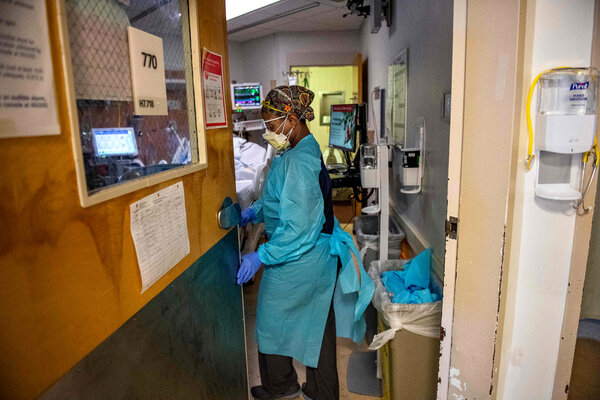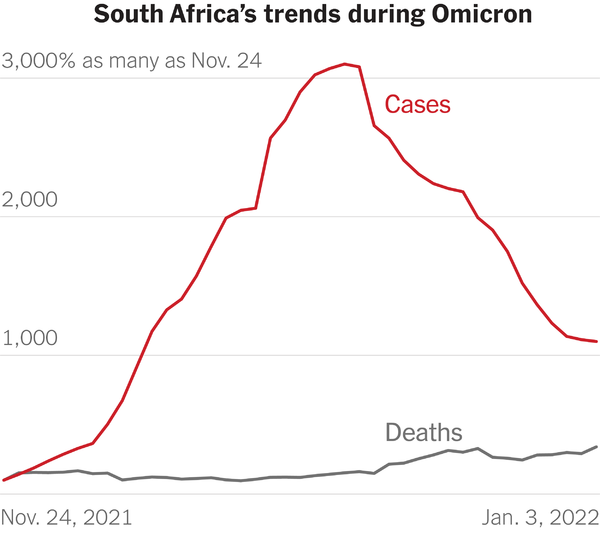Jan 5, 2022
Article from The New York Times. View in browser.

Treating Covid patients at a hospital in Worcester, Mass., yesterday. Joseph Prezioso/Agence France-Presse — Getty Images
'Not the same'
- The details of the Omicron variant are becoming clearer, and they are encouraging.
They're not entirely encouraging, and I will get into some detail about one of the biggest problems — the stress on hospitals, which are facing huge numbers of moderately ill Covid-19 patients. But regular readers of this newsletter know that I try to avoid the bad-news bias that often infects journalism. (We journalists tend to be comfortable delivering bad news straight up but uncomfortable reporting good news without extensive caveats.)
So I want to be clear: The latest evidence about Covid is largely positive. A few weeks ago, many experts and journalists were warning that the initial evidencefrom South Africa — suggesting that Omicron was milder than other variants — might turn out to be a mirage. It has turned out to be real.
“In hospitals around the country, doctors are taking notice," my colleagues Emily Anthes and Azeen Ghorayshi write. “This wave of Covid seems different from the last one."
There are at least three main ways that Omicron looks substantially milder than other versions of the virus:
1. Less hospitalization
Somebody infected with Omicron is less likely to need hospital treatment than somebody infected with an earlier version of Covid.
An analysis of patients in Houston, for example, found that Omicron patients were only about one-third as likely to need hospitalization as Delta patients. In Britain, people with Omicron were about half as likely to require hospital care, the government reported. The pattern looks similar in Canada, Emily and Azeen note.
Hospitalizations are nonetheless rising in the U.S., because Omicron is so contagious that it has led to an explosion of cases. Many hospitals are running short of beds and staff, partly because of Covid-related absences. In Maryland, more people are hospitalized with Covid than ever.
“Thankfully the Covid patients aren't as sick. But there's so many of them," Craig Spencer, an emergency room doctor in New York, tweeted on Monday, after a long shift. “The next few weeks will be really, really tough for us."
The biggest potential problem is that overwhelmed hospitals will not be able to provide patients — whether they have Covid or other conditions — with straightforward but needed care. Some may die as a result. That possibility explains why many epidemiologists still urge people to take measures to reduce Covid's spread during the Omicron surge. It's likely to last at least a couple more weeks in the U.S.
2. Milder hospitalization
Omicron is not just less likely to send somebody to the hospital. Even among people who need hospital care, symptoms are milder on average than among people who were hospitalized in previous waves.
A crucial reason appears to be that Omicron does not attack the lungs as earlier versions of Covid did. Omicron instead tends to be focused in the nose and throat, causing fewer patients to have breathing problems or need a ventilator.
As Dr. Rahul Sharma of NewYork-Presbyterian/Weill Cornell told The Times, “We're not sending as many patients to the I.C.U., we're not intubating as many patients, and actually, most of our patients that are coming to the emergency department that do test positive are actually being discharged."
In London, the number of patients on ventilators has remained roughly constant in recent weeks, even as the number of cases has soared, John Burn-Murdoch of The Financial Times noted.
3. And deaths?
In the U.S., mortality trends typically trail case trends by about three weeks — which means the Omicron surge, which began more than a month ago, should be visible in the death counts. It isn't yet:

Data as of Jan. 3.Source: New York Times database
Covid deaths will still probably rise in the U.S. in coming days or weeks, many experts say. For one thing, data can be delayed around major holidays. For another, millions of adults remain unvaccinated and vulnerable.
But the increase in deaths is unlikely to be anywhere near as large as the increase last summer, during the Delta wave. Look at the data from South Africa, where the Omicron wave is already receding:

South Africa reported identification of Omicron on Nov. 24. Source: Johns Hopkins University
The bottom line
Given the combination of surging cases and milder disease, how should people respond?
Dr. Leana Wen, Baltimore's former health commissioner, wrote a helpful Washington Post article in which she urged a middle path between reinstituting lockdowns and allowing Omicron to spread unchecked.
“It's unreasonable to ask vaccinated people to refrain from pre-pandemic activities," Wen said. “After all, the individual risk to them is low, and there is a steep price to keeping students out of school, shuttering restaurants and retail shops and stopping travel and commerce."
But she urged people to get booster shots, recommended that they wear KN95 or N95 masks and encouraged governments and businesses to mandate vaccination. All of those measures can reduce the spread of Covid and, by extension, hospital crowding and death.
What about elderly or immunocompromised people, who have been at some risk of major Covid illness even if they're vaccinated?
Different people will make different decisions, and that's OK. Severely immunocompromised people — like those who have received organ transplants or are actively receiving cancer treatment — have reason to be extra cautious. For otherwise healthy older people, on the other hand, the latest data may be encouraging enough to affect their behavior.
Consider this: Before Omicron, a typical vaccinated 75-year-old who contracted Covid had a roughly similar risk of death — around 1 in 200 — as a typical 75-year-old who contracted the flu. (Here are the details behind that calculation, which is based on an academic study.)
Omicron has changed the calculation. Because it is milder than earlier versions of the virus, Covid now appears to present less threat to most vaccinated elderly people than the annual flu does.
The flu, of course, does present risk for the elderly. And the sheer size of the Omicron surge may argue for caution over the next few weeks. But the combination of vaccines and Omicron's apparent mildness means that, for an individual, Covid increasingly resembles the kind of health risk that people accept every day.
